SpotBot® 2 Protein
Data Sheet
![]() Shop this product in our online store
Shop this product in our online store
Products - Microarrayers - SpotBot® 2 Protein Desktop Personal Protein Microarray Printers
With more than 325 systems installed worldwide, SpotBot® is the world’s most popular personal microarray instrument. Proprietary cooling technology affords high quality protein microarrays on your desktop.

ArrayIt® offers this revolutionary turnkey system for desktop protein microarray manufacturing. SpotBot® 2 Protein Edition (SPA2PRO) utilizes advanced micro-robotics to ensure accuracy, ease-of-operation and affordability, with built-in cooling and humidity controls, allowing the user to cool the robot to 4°C while maintaining proper humidity during use. SpotBot® 2 PRO will print 384 protein samples onto 14 substrates in 2 hours using four patented 946 or Stealth Micro Spotting Pins. SpotBot® 2 PRO is the perfect complement to any microarray core facility and the ideal personal protein microarrayer for innovative research and diagnostics.
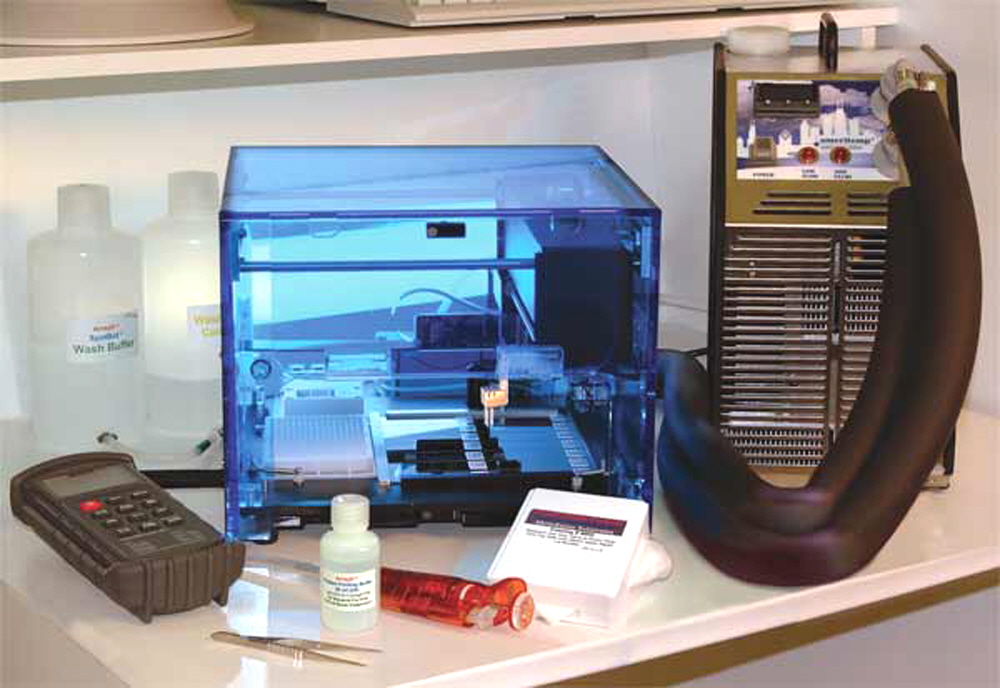
The SpotBot® 2 Protein Edition (SPA2PRO) includes a high-performance chiller bath for rapid and accurate cooling of the entire printing deck.
Click HERE to view the Multiple Microarray SpoCLe Generator.
Click HERE to view the Biacore SpoCLe Generator.
Click HERE to view the 96 & 384 Well Plate SpoCle Generator
NEW!! Humidity Control Apparatus for SpotBot 2.
NEW!! Megasonic Wash Station Upgrade!
Gal file generation help file: http://www.spotsupport.com/downloads/GALCreatorV1.0.02HELP.pdf
SpotBot® 2 Protein Edition System Features and Specifications
- SpotBot® 2 PRO represents a major advance over the original SpotBot® PRO
- Improved speed, precision and durability
- Built-in cooling (4°C) and humidity control (10-80% RH)
- System includes hygrometer and thermometer
- Axis resolution and repeatability of ±10 µm
- Arrayit International’s patented printing technology (U.S. 6,101,946)
- 4-pin printhead configuration (2 x 2 at 4.5 mm spacing)
- Compatible with all Stealth and 946 Micro Spotting Pins
- Holds 14 standard sized glass substrates (25 x 76 mm)
- Holds one 384-well microplate for protein samples
- Printing routines allow 1-5 spots per protein sample
- 3,600 spots per sub-microarray (9 x 9 mm)
- 50,400 spots per entire substrate (18 x 63 mm)
- Printing time of 2 hrs per 384-well microplate
- >1,000 samples in 6 hours
- Compatible with Windows XP, 2000, and NT 4.0
- Power requirements: Standard 120 or 220 volt outlets
- Ease-of-operation via new version 3 Graphical User Interface (GUI)
- Robot size (H x L x W): 22 cm (8.7 in) x 30 cm (11.8 in) x 30 cm (11.8 in)
- Robot weight: 6.4 Kg (14 lbs) including vacuum and peristaltic pumps
- Chiller bath adds extra weight and expands the system footprint by ~2-fold
Unique Features of the SpotBot® 2 Protein Edition System
- World’s only truly portable protein microarrayer (volume = 1.0 ft3)
- World’s only turnkey desktop protein microarray manufacturing system
- Installation time <120 minutes
- Create a miniature “cold room” right on your desk
- Flow-through platen cooling maximizes chilling uniformity
- Arrives pre-calibrated from our laboratories in California
- Only system that uses micro-robotics for motion control
- “Zero” thermal emission, ultra-low energy consumption, and quiet operation
- Uses a forced air stream for pin drying, providing "zero" sample carry-over
- Super fast humidity control of 5% per minute and ±1 % at steady state
- Ultra-low wash buffer consumption of <1.0 liter per 8 hours of operation
- Ultra-low air turbulence minimizes sample evaporation during printing
- Ultra-low vibration improves printing quality and eliminates disruption of analytical balances, microscopes, scanners and other sensitive equipment
- Private label and OEM packages available to volume customers
- Only personal protein microarrayer in the world
SpotBot® 2 Protein Edition System Components
- 1 SpotBot® 2 Protein Edition Microarrayer
- 1 Temperature-Controlled Chiller Bath with Cooling Solution
- 1 Humidification-Dehumidification Apparatus (see photo below)
- 1 Digital Hygrometer for Measuring Relative Humidity (RH)
- 1 Digital Thermometer for Measuring Robot Platen Temperature
- 1 Stealth or 946 4-Pin Printhead
- 4 SMP4 or 946MP4 Pins (or customer’s choice of any pin size)
- 1 Calibration Pin (to check factory or customer calibration)
- 1 Substrate Locator L-Bracket
- 1 Air Compressor to Power the Dry Station
- 1 Peristaltic Pump to Power the Wash Station
- Complete Tubing Set (installed at factory)
- 1 Wash Buffer Reservoir (1 liter)
- 1 Waste Buffer Container (1 liter)
- 1 Liter SpotBot® 2 Wash Buffer
- 1 x 50 ml 2X Protein Printing Buffer
- 1 x 25 SuperEpoxy Microarray Substrates
- 1 x 384-Well Microplate for protein samples
- 1 Voltage Adaptor (110-220 volt)
- 1 COM Port Data Transfer Cable
- 1 SpotSuite Software Installation CD
- 1 Calibration Floppy Disc (must be installed!!)
- Full One-Year Parts and Warranty Package (extra charge)
- (Option) Megasonic Wash Station
Important Technical Note
Your SpotBot® 2 Protein Edition Microarrayer is calibrated in our laboratories in California to ensure proper Z-axis height over the substrates and platen, and correct pin placement in the wash and dry station, and 384-well microplate. These calibration files are provided on a floppy disc in addition to the SpotSuite 3 installer CD. Calibration files are unique to your system and must be installed prior to operating your SpotBot® 2 Protein Edition system!!
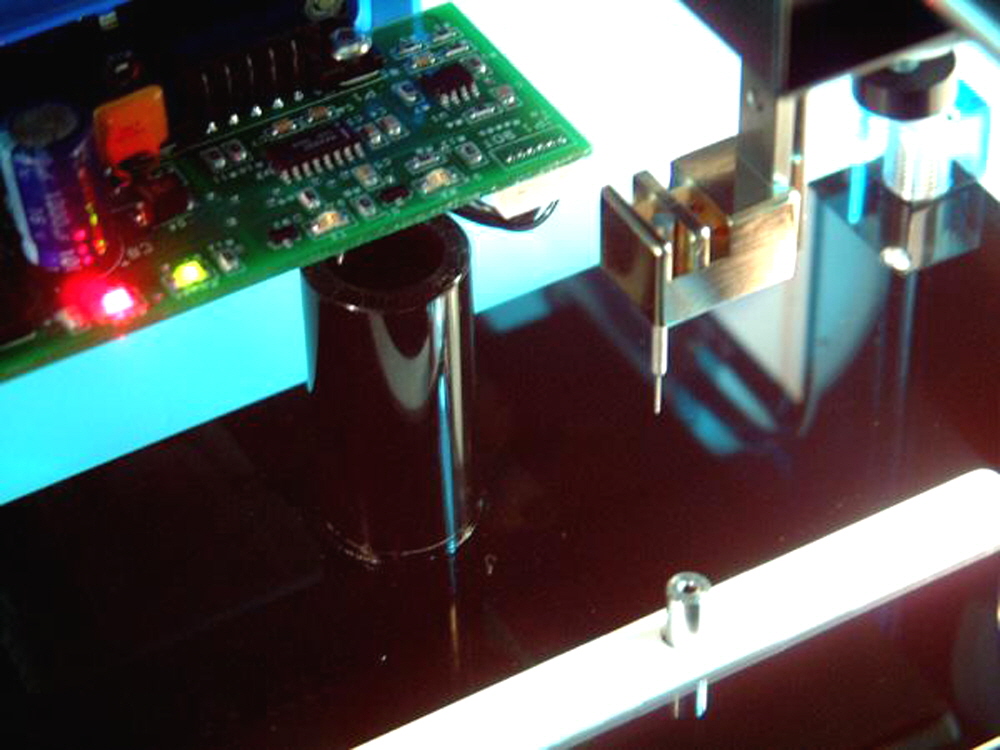
Figure 1. Shown is theSpotBot® 2 Protein Edition Microarrayer printed circuit board and and operation lights. Operation is computer-controlled and fully automated. The printhead shown in this photograph contains a calibration pin in the first of 4 pin apertures.
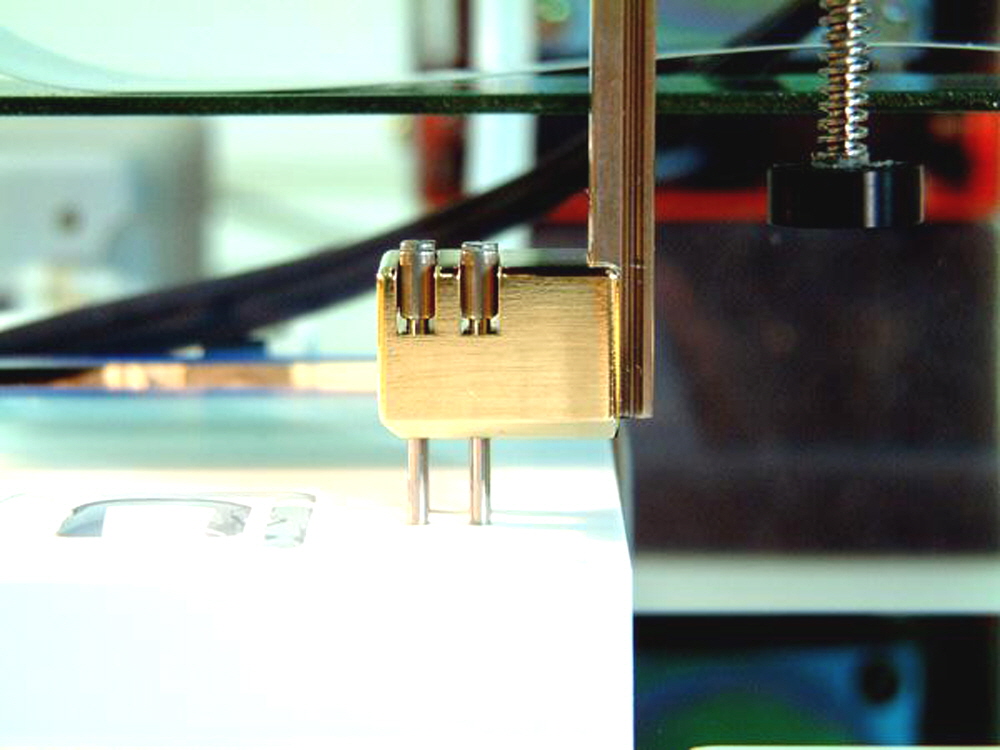
Figure 2. Shown is the wash and dry station of the SpotBot® 2 Protein Edition Microarrayer, with the wash port (left) and the drying port (right). The printhead containing 4 Stealth Pins is fully inserted into the dry station in this photograph such that the collars rise above the top surface of the printhead by about 1.0 mm. Customers can also use 946 Pins with extended collars for ease-of-handling and greater printing precision. A forced air stream generated by the SpotBot® 2 Protein Edition Microarrayer Air Compressor dries each pin independently, essentially eliminating sample carry-over. Cross-contamination can be further reduced further by using the Megasonic Wash Station option, a favorite of protein microarray researchers.

Figure 3. Shown is theSpotBot® 2 Protein Edition Microarrayer in the protein sample loading position. After the wash/dry step, the 4-pin Printhead moves over the first loading position in the 384-well microplate, lowers to the bottom of the plate, and pauses for 3 seconds allowing the protein samples to load into the pin tips by capillary action. Each pin loads 0.2 µl of protein sample using the SMP4 or 946MP4 pin design. The recommended sample volume is 5-10 µl per well in a 384-well microplate and the recommended protein concentration is 0.1-1.0 µg/µl. The SpotBot® 2 Protein Edition Microarrayer will print an entire 384-well microplate across 14 protein microarray substrates in less than 2 hours.

Figure 4. Microarray printed with dilutions of ArrayIt® Green540 and Red640 fluorescent dyes using theSpotBot® 2 Protein Edition Microarrayer equipped with four 946MP4 Pins and a 946PH4 Printhead. All samples were printed in quintuplicate at 200-µm center-to-center spacing. The uniformity of the rows and columns of printed spots reveals the excellent printing performance of the SpotBot® 2 Protein Edition Microarrayer. The space bar denotes 500 µm in the image.

Figure 5. Shown is the Humidification System for adding humidity to the SpotBot® 2 Protein Edition Microarrayer chamber. An Air Compressor and Humidification Flask power humidification of the internal chamber of the SpotBot® 2 to be controlled within 1%. See Fig. 9 below for the dehumidification apparatus.
Rationale for the SpotBot® 2 Protein Edition “Cold Room”
Proteins have a number of levels of structural organization including primary structure (amino acid sequence, held together by covalent bonding), secondary structure (e.g. coiled-coils and beta-pleated sheets, held together primarily by hydrogen bonding), tertiary structure (overall protein shape, mediated by hydrogen bonding, disulfide bonds, etc.) and quaternary structure (which combines multiple protein subunits using hydrogen and other types of bonds to maintain subunit affinity). Each one of these levels of organization is required for protein activity, and these levels of organization must be maintained during and after microarray printing for successful protein microarray experimentation. In addition, intact epitope structure is a requirement for antibody binding and therefore antigen and antibody microarrays. Hydrogen bonding, a key force in maintaining protein folding, has a temperature-dependant component. Temperature-dependant changes in hydrogen bonding can result in protein denaturation and functional inactivation. This is easily observed when a protein source such as an egg white is heated to high temperatures during cooking. This same effect happens at lower temperatures. The rate of protein denaturation doubles every 5-10°C. This helps explain why proteins maintain their properly folded conformations much longer in the cooled SpotBot® 2 Protein Edition Microarrayer chamber versus traditional microarrayers. Another key factor that diminishes protein integrity is bacterial and fungal contamination. The doubling time of microbes is greatly reduced at lower temperatures, which is yet another advantage of the cooled SpotBot® 2 Protein Edition Microarrayer chamber. The optimal temperature for most proteins is 4-10°C. For the last one hundred years, protein biochemistry has been performed in the cold room. Now, ArrayIt® brings the cold room to your desktop.
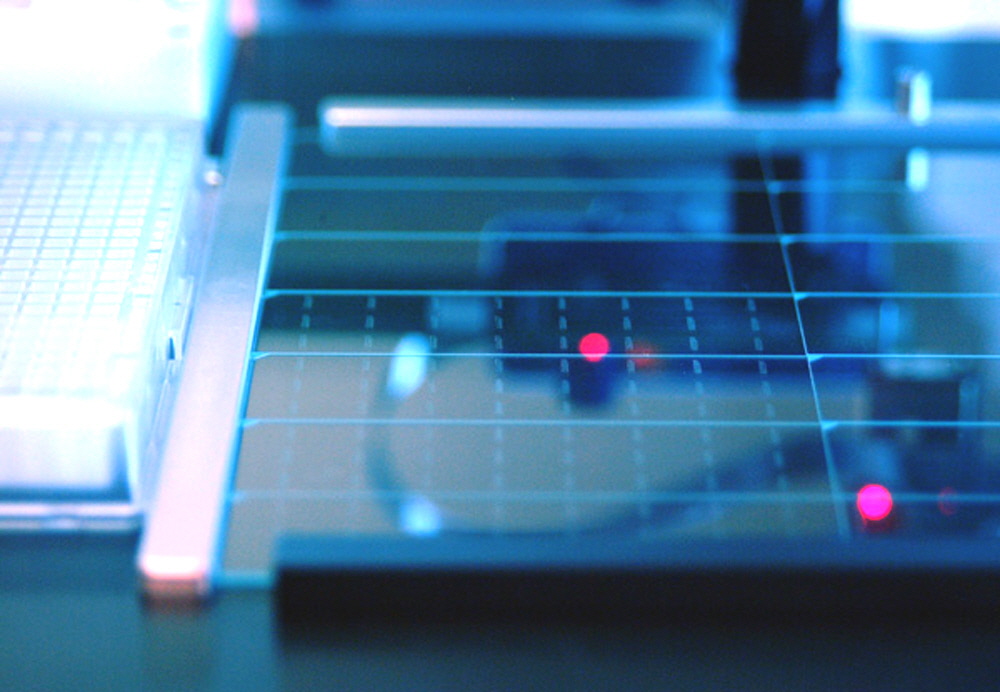
Figure 6. Multiple microarrays per substrate printed with a SpotBot® 2 Personal Microarray Robot. Shown is a photograph of the SpotBot® 2 platen containing SuperAmine Microarray Substrates printed with a SpotBot® 2 Personal Microarrayer running 946MP4 Pins printing at 175 µm spacing. A total of 24 microarrays per substrate were printed using the Multiple Microarray Format SpoCLe Generator version 1.1.02, which can be downloaded at http://spotsupport.com.
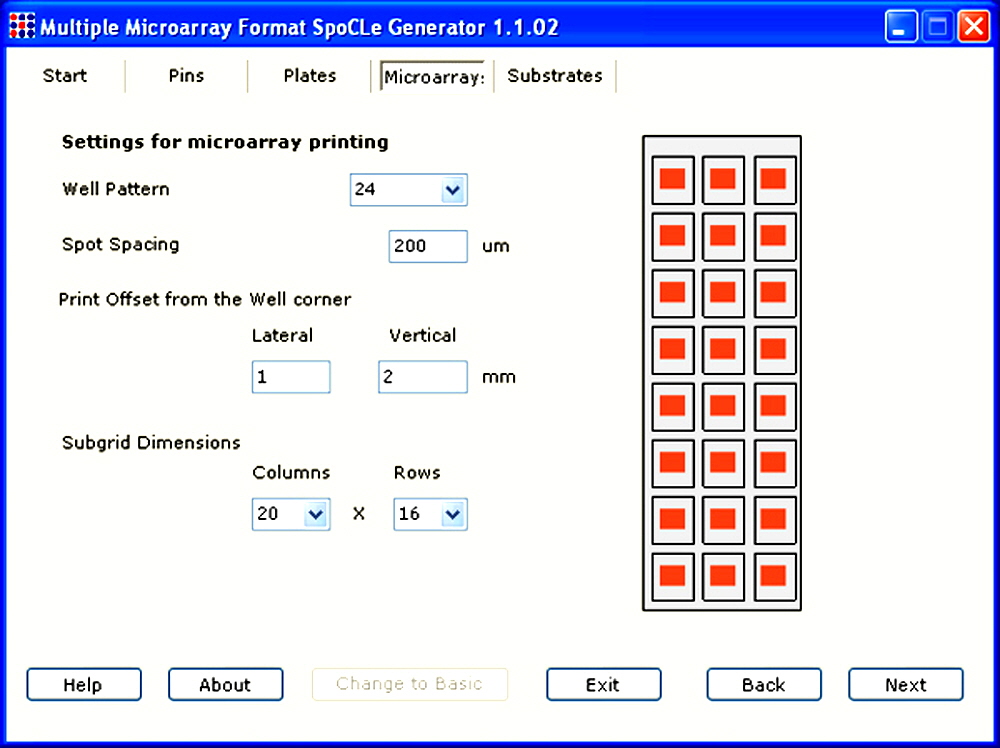
Figure 7. Multiple Microarray Format SpoCLe Generator version 1.1.02 allows the printing of multiple microarrays per substrate with SpotBot 2 Personal Microarrayers (see Fig. 6). Shown is a screenshot of the software interface. The user selects the number of microarrays or “well pattern”, spot spacing in microns, print offsets in millimeters, and subgrid dimensions as columns and rows. The software then generates a graphic showing how the printed microarrays (orange icons) will appear on the substrates. The Multiple Microarray Format SpoCLe Generator version 1.1.02 can be downloaded at http://spotsupport.com.

Figure 8. Shown is a photograph of the Peristaltic Pump used on SpotBot®2 Personal Microarrayers. Tubing colors should be configured as shown. The speed dial should be set to the right (CW, clockwise setting) for correct buffer flow into the Wash Station. Pumps are either 12 rpm or 100 rpm as designated on the back of the instrument under “speed”. A proper buffer flow rate of 1.0 ml/min into the SpotBot®2 Wash Station is achieved using dial setting 8 (12 rpm pump) or dial setting 1 (100 rpm pump, shown here). Tubing connections (not shown) should be green-green, blue-blue, yellow-yellow, and white-white as designated on the tubing ends and hardware: green-green = Peristaltic Pump intake to Wash Buffer Reservoir; blue-blue = Peristaltic Pump intake to Wash Station outlet; white-white = Peristaltic Pump outlet to Wash Station intake; yellow-yellow = Peristaltic Pump outlet to Wash Waste Container.
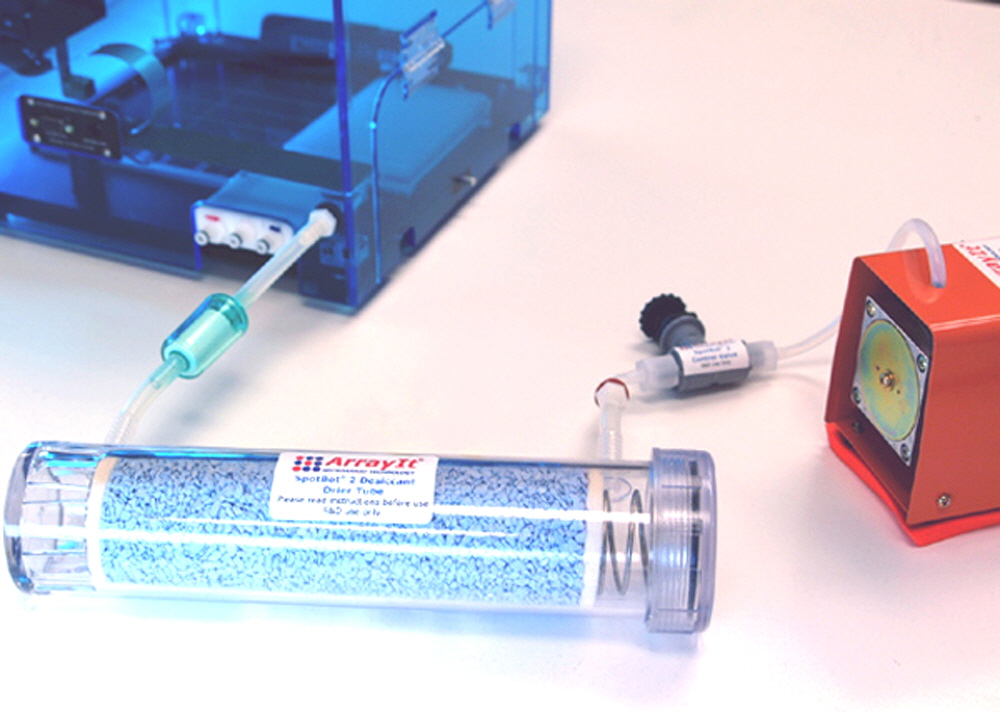
Figure 9. Shown is the Dehumidification Apparatus attached to the correct port on the SpotBot® 2 Protein Edition Personal Microarrayer. The Air Compressor (orange) pushes air through a user-controlled valve and into the dessicant tube. De-humidified air is then filtered (green filter) to remove particulate matter, and propelled under pressure into the SpotBot® 2 instrument. The Dehumidification Apparatus prevents excessive humidity from accumulating when the instrument platen is cooled below ambient temperature. Humidity can be held within 1% of the desired level. The Humidification Apparatus (see Fig. 5) is ported onto the same fitting as the Dehumidification Apparatus.

Figure 10. Shown is a photograph of the SpotBot®2 Microarrayer including the accessories. The translucent wash buffer reservoir, orange air compressor for the dry station, silver peristaltic pump for the wash station, silver megasonic power supply and humidification system including the orange air compressor, humidification reservoir and gray valve are shown correctly configured behind the instrument. The modular and compact accessories improve system utility and performance and simplify maintenance and repair. Inside the instrument, the microplate, L-bracket and temperature/humidity pen are visible. The SpotBot®2 Protein Edition Microarrayer is configured similarly except that the humidification is replaced by dehumidification (see Figure 9) and a chilller bath is added for deck cooling.
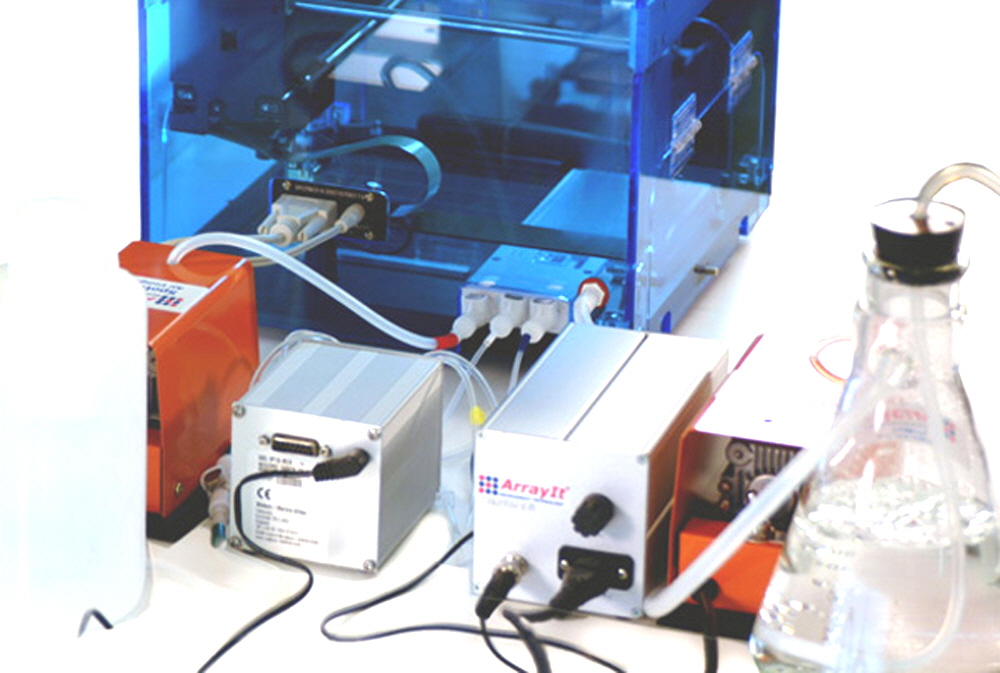
Figure 11. Shown is a photograph of the SpotBot®2 Personal Microarrayer including the accessories. The translucent wash buffer reservoir, orange air compressor for the dry station, silver peristaltic pump for the wash station, silver megasonic power supply and humidification system including the orange air compressor and humidification reservoir are shown correctly configured behind the instrument. The COM cable, power supply, dry station fitting (red), wash buffer fitting (white), waste buffer outtake (blue), and humidification tubing are shown correctly attached to the back of the instrument. The modular and compact accessories design improves system utility and performance and simplifies maintenance and repair. The SpotBot®2 Protein Edition Microarrayer is configured similarly except that the humidification is replaced by dehumidification (see Figure 9) and a chilller bath is added for deck cooling.
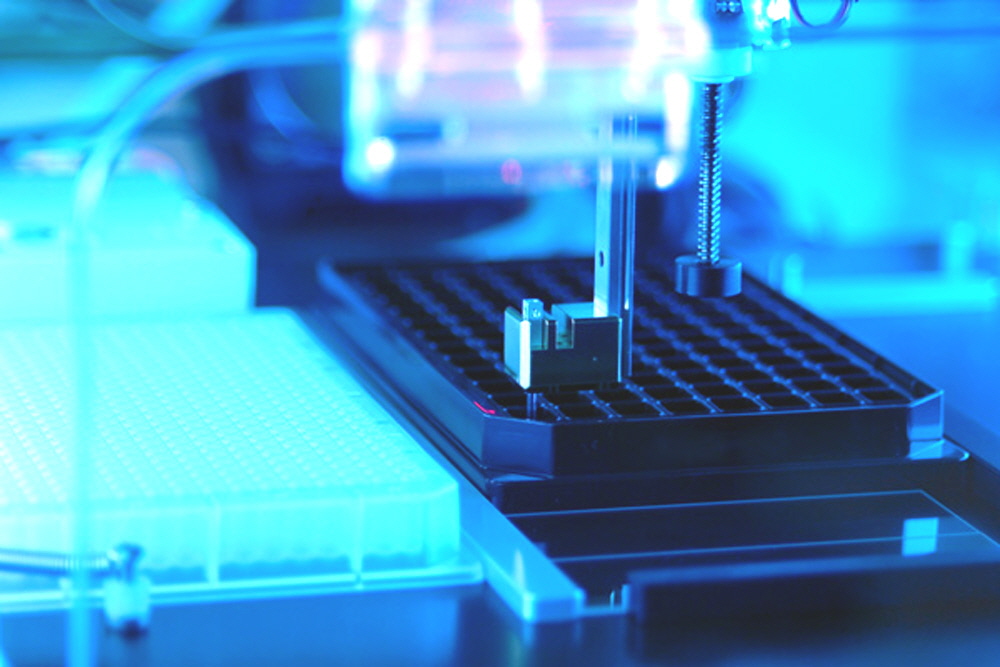
Figure 12. SpotBot®2 Microplate Printing. SpotBot®2 Protein Edition Personal Microarrayers enable microarray printing into 96-well microplates (shown) and 384-well microplates, as well as onto microplate-sized glass substrates using the standard SpotBot®2 Protein Edition components and Well Plate Printing Spocle Generator v2.0.2 software running on SpotApp v3.5.7. Microplate printing software is downloadable on the SpotSupport web site. Microplate printing requires the Microplate L-Bracket Locator (Cat. MLS) to hold the microplate in position during printing, and utilizes two pre-print substrates as shown here. System calibration is required prior to printing. Please do not attempt microplate printing prior to system calibration.

